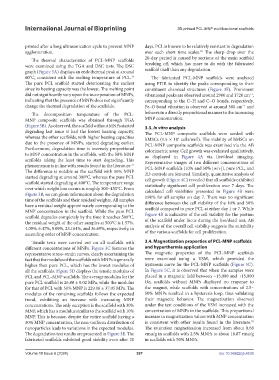Page 405 - IJB-10-6
P. 405
International Journal of Bioprinting 3D-printed PCL-MNP multifunctional scaffolds
printed after a long ultrasonication cycle to prevent MNP days. PCL is known to be relatively resistant to degradation
agglomeration. over such short time scales. The sharp drop over the
38
20-day period is caused by sections of the main scaffold
The thermal characteristics of PCL-MNP scaffolds
were examined using the TGA and DSC tests. The DSC breaking off, which has more to do with the fabricated
graph (Figure 3A) displays an endothermal peak at around scaffold itself than any degradation.
60°C, consistent with the melting temperature of PCL. The fabricated PCL-MNP scaffolds were analyzed
36
The pure PCL scaffold started deteriorating the earliest using FTIR to identify the peaks corresponding to their
since its heating capacity was the lowest. The melting point constituent chemical structures (Figure 3F). Prominent
did not significantly vary upon the incorporation of MNPs, vibrational peaks are observed around 2900 and 1720 cm ,
−1
indicating that the presence of MNPs does not significantly corresponding to the C–H and C–O bonds, respectively.
change the thermal degradation of the scaffolds. Fe–O bond vibration is observed at around 580 cm and
−1
The decomposition temperature of the PCL- behaves in a directly proportional manner to the increasing
MNP composite scaffolds was obtained through TGA MNP concentration.
(Figure 3B). As observed, the scaffold without MNPs started 3.3. In vitro analysis
degrading last since it had the lowest heating capacity, The PCL-MNP composite scaffolds were seeded with
whereas the other scaffolds, with higher heating capacities hMSCs (1.5 × 10 cells/well). The viability of hMSCs on
4
due to the presence of MNPs, started degrading earlier. PCL-MNP composite scaffolds was examined via the AB
Furthermore, degradation time is inversely proportional colorimetric assay. Cell growth was evaluated qualitatively,
to MNP concentration in the scaffolds, with the 50% MNP as displayed in Figure 4A via live/dead imaging.
scaffolds taking the least time to start degrading. This Representative images of two different concentrations of
phenomenon is in line with results found in the literature. PCL-MNP scaffolds (10% and 50% [w/v]), pure PCL, and
37
The difference is notable as the scaffold with 50% MNP 2D controls are featured. Similarly, quantitative analysis of
started degrading at around 300°C, whereas the pure PCL cell growth (Figure 4C) revealed that all scaffolds exhibited
scaffold started degrading at 400°C. The temperature range statistically significant cell proliferation over 7 days. The
over which weight loss occurs is roughly 300–450°C. From calculated cell viabilities presented in Figure 4B were
Figure 3B, we can glean information about the degradation ≥90% for all samples on day 7. There was no significant
time of the scaffolds and their residual weights. All samples difference between the cell viability of the 10% and 50%
have a residual weight approximately corresponding to the
MNP concentration in the scaffold. While the pure PCL scaffold compared to pure PCL at either day 1 or 7. While
scaffold degrades completely by the time it reaches 500°C, Figure 4B is indicative of the cell viability for the portion
of the scaffold under focus during the live/dead test, AB
the residual weight of the other samples at 500°C is 1.57%,
4.09%, 6.47%, 9.09%, 23.164%, and 36.69%, respectively, in analysis of the overall cell viability suggests the suitability
ascending order of MNP concentration. of the various scaffolds for cell proliferation.
Tensile tests were carried out on all scaffolds with 3.4. Magnetization properties of PCL-MNP scaffolds
different concentrations of MNPs. Figure 3C features the and hyperthermia application
representative stress–strain curves, clearly ascertaining the The magnetic properties of the PCL-MNP scaffolds
fact that the modulus of the scaffolds with MNPs is generally were examined using a VSM, which provided the
higher than pure PCL, which has the lowest modulus of hysteresis curve for the PCL-MNP scaffolds (Figure 5C).
all the scaffolds. Figure 3D displays the tensile modulus of In Figure 5C, it is observed that when the samples were
PCL and PCL-MNP scaffolds. The average modulus for the placed in a magnetic field between −15,000 and +15,000
pure PCL scaffold is 26.88 ± 9.02 MPa, while the modulus Oe, scaffolds without MNPs displayed no response to
for that of PCL with 50% MNP is 229.06 ± 37.05 MPa. The the magnet, while scaffolds with concentrations of 2.5–
modulus of the remaining scaffolds follows the expected 50% MNPs resulted in a hysteresis loop, thus validating
trend, exhibiting an increase with increasing MNP their magnetic behavior. The magnetization observed
concentrations. The only exception is the scaffold with 30% under the test conditions of the VSM increased with the
MNP, which has a modulus similar to the scaffold with 10% concentration of MNPs in the scaffolds. This proportional
MNP. This is because, despite the entire scaffold having a increase in magnetization values with MNP concentration
39
30% MNP concentration, the non-uniform distribution of is consistent with other results found in the literature.
nanoparticles leads to variations in the expected modulus. The saturation magnetization increased from about 0.68
The degradation test results are presented in Figure 3E. The emu/g in scaffolds with 2.5% MNPs to about 16.87 emu/g
fabricated scaffolds exhibited good stability even after 20 in scaffolds with 50% MNPs.
Volume 10 Issue 6 (2024) 397 doi: 10.36922/ijb.4538

